From the initial cost of a bike and gear to the ongoing maintenance and upgrades over the years, Mountain Biking can really add up.
For most riders, that forces us to really view our bikes as investments as opposed to just purchases.
Naturally, you want to do everything you can to protect your investment. From frequent baths to yearly tune-ups, it’s normal to make sure you’re doing everything you can to get the most out of your Mountain Bike.
And we’re right there with you, that’s why we created this article to tell you everything you need to maintain your Hardtail Mountain Bike.
Clean and Inspect the Frame

Clean – A basic cleaning consists of wetting your bike down with a low pressure of water and scrubbing off all the dirt and grime. You can use something as accessible as Dawn dish soap or a more dedicated bike wash like Muc-off’s Nano Tech Bike Cleaner to get everything squeaky clean. Try to avoid spraying water directly towards any bearings or bushings so you don’t remove any lubrication from the bike.
Inspection – Once your bike is clean, begin checking for any damage to the frame. You want to check for dents, scratches, chips, cracks, or bends. Check the Headtube, Downtube, Chain stay, Seat Stay, and seat tube. You should also check all the welds, starting with the Headtube.
Frequency – After and Before each ride
Starting with one of the easiest yet most crucial things to maintain, make sure you’re keeping your bike clean and regularly inspecting the Frame for damage.
This is one of the best ways to prolong the life of your Hardtail, mechanically and aesthetically.
Cleaning your bike frame helps keep the dirt and grime out of places like the Headset and Bottom Bracket, saving you costly repairs in the future.
Keeping your frame clean can also help you spot signs of damage, something that is a major concern for safety.
Spotting frame damage during cleaning can help you avoid serious injury in the future.
Here is a detailed guide on checking your Bike Frame.
Check Tire Pressure

Check Tire Pressure – Grab yourself a digital tire gauge and check out a resource like Bicycling.com’s tire pressure guide to see what tire pressure you should be running. You can also take a trip to your LBS to see what they recommend for your weight and riding style.
Frequency – weekly or as needed
The next thing is something you’re probably already familiar with – your Tire Pressure.
Since tires are the only “suspension” available on a Hardtail, regulating Tire Pressure becomes slightly more important.
In fact, the Tire Pressure is responsible for things like handling, traction, rolling resistance, and comfort.
Running tires with too low or too high PSI can cause unnecessary damage to your wheelsets and even your bike.
For a more detailed video on tire pressure, check out this video from GMBN.
Inspect your Brakes
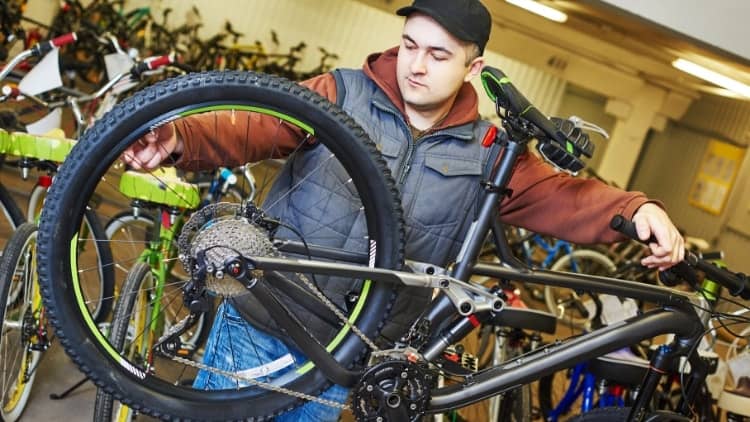
Pads – Make sure you’re checking your brake pads before every ride, especially if you notice squeaking. Clean the pads with an alcohol solution after muddy rides and replace them when they’re less than 3mm thick or no longer effective.
Discs – Inspect your brake discs for scratches and damage. Maintaining your brake pads and making sure you clean your bike will prevent any disc issues.
Levers – Make sure your levers are positioned appropriately and tightened enough to keep them stationary, but not too tight.
Frequency – Every 3-5 days
Believe it or not, your brakes do more than just slow you down, they are also important for the longevity of your Hardtail.
If you want to extend the life of your Hardtail, make sure you perform regular brake checks.
Checking your brakes regularly can help you know when to change the pads but can also tell you specific information on how you’re riding and how the parts of your bike are wearing down.
Your brakes also have a significant effect on your performance.
Worn brakes don’t give you the same confidence going into fast turns or tackling steep descents. You will find yourself taking it easier than normal, while still putting yourself at risk.
Just like the frame, this is an important thing to inspect and repair if you notice damage.
If you have Disc Brakes, check out this guide on Disc Brake Maintenance.
Inspect the Drivetrain
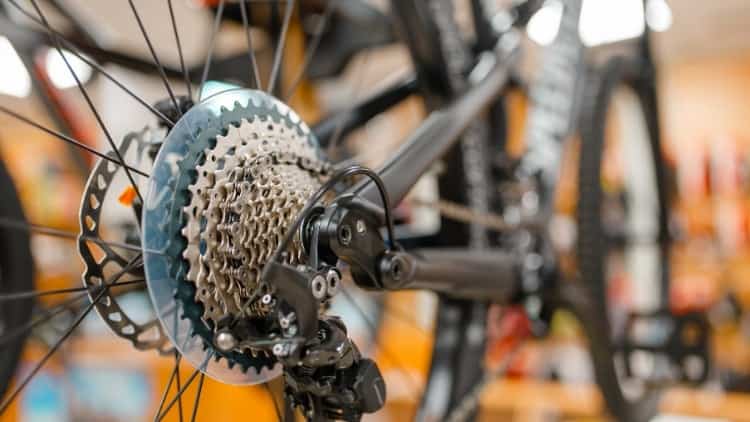
Chain – Use a Chain Cleaner like Park Tools to get all the dirt and grime from in between the teeth. Once dry, apply a liberal amount of lube and wipe the excess with a clean cloth.
Derailleur and Mech – Keep your derailleurs clean and aligned correctly to ensure smooth shifting.
Frequency – 1-2 times per week
The next thing on the list is the main driving force behind the whole bike – the Drivetrain.
Consisting of all parts from the chain to the cogs on the rear derailleur, the drivetrain is the system that allows you to pedal your bike forward.
Naturally, this is one of the most important things to maintain if you want to improve the life of your Hardtail.
Keeping a clean bike helps prevent any issues with this system, however, a Drivetrain still takes extra care and attention when servicing.
Make sure you apply the appropriate lubrication and always work to keep water out of the bearings and brackets.
If you’re having an issue with your Drivetrain, make sure you check out this video by Park Tools.
Bolt and Screw Check
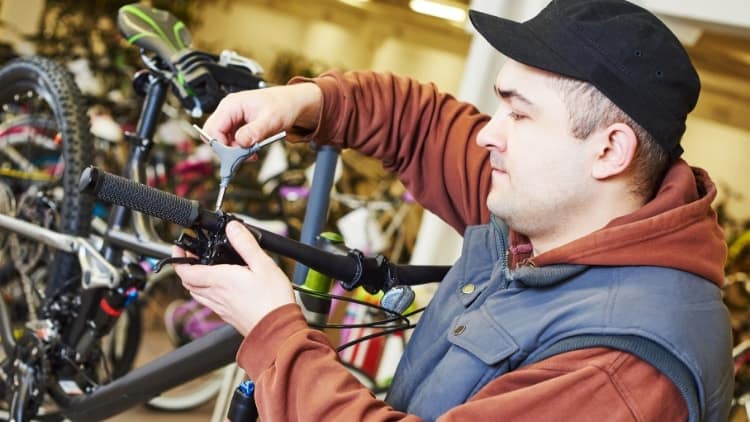
Inspect – Use a torque wrench and multi-tool to make sure all the bolts on your bike are tightened to spec. Check everything from the cockpit to the rear derailleur and don’t worry, this is typically a one-time deal.
Frequency – Monthly
Tightening the bolts and screws on your bike can seem like a daunting task at first, but it is definitely worth the once over.
This is how you prevent things like twisted handlebars, spinning grips, and rattling noises.
Aside from the obvious safety reasons, this is a great way to increase the life of your Hardtail and its components.
Make sure you don’t tighten any bolts too snug, especially if you’re riding a carbon Hardtail. This is a good time to invest in a torque wrench if you can.
Check the Cables and Housing
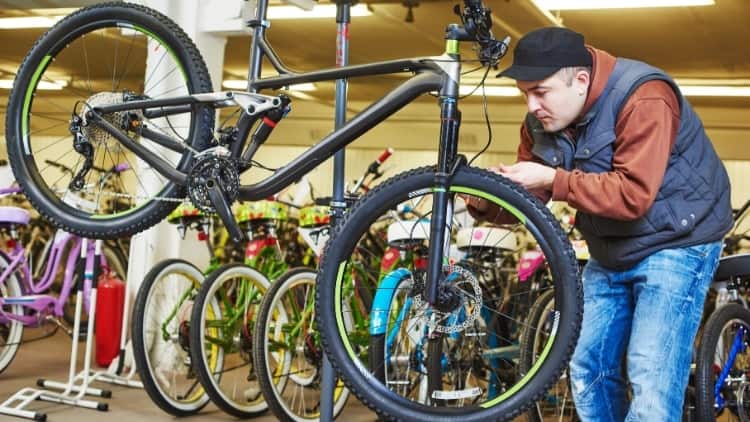
Clean – Every few days, make sure you wipe down the housing as well as the cabling with a soft rag. Particularly dirty cabling may require disassembly and replacement.
Lubricate – After cleaning your bike, it is good practice to rub a small amount of lubrication on the exposed areas of the cable.
Frequency – Weekly
Although this area is usually covered with a good bike wash, don’t forget to take extra care of your brake and gear cabling and housing.
In fact, your cables play a vital role in actuating the most important components on your bike; shifting gears, braking, and locking out suspension.
If you notice any delay or friction when you pull on your brakes or shift levers, there’s a good chance you have an issue with the cables or housing.
Even worse, if you leave your cables damaged for too long, they can fray or snap completely.
Rust, dirt and old oil can all damage or shorten the life of your cables, so make sure you take care weekly to inspect and clean when necessary.
For a great resource on changing your cables, check out this YouTube video.
Check Suspension

Inspect – Check your fork stanchions for signs of damage. Then hold your front brakes and rock the bike forward to see if you notice movement in the fork. Take the time to check for any suspicious noise or movement.
Clean – Carefully wipe the stanchions if they get dirty, and keep the dirt from getting in the seals.
Lubricate – You don’t really need to lubricate the forks unless you’re doing a service.
Service – Remove the bottom fork and replace the seals and lubrication. Add air if applicable.
Frequency – As needed
Your forks are the only suspension you have on your Hardtail, so make sure you don’t forget to service them every now and then.
Other than the occasional cleaning, there’s not too much to maintain a front suspension fork.
In fact, you don’t even need to lubricate the fork stanchions. The oil in the bottom of the fork should be enough to keep them lubricated.
But make sure you keep them clean.
Letting dirt get into your front suspension fork can potentially cause permanent damage to the components, prompting costly repair.
Keep an eye out for movement when you have the front brake locked, as this could point to worn-out seals and bushings.
If you hear any rattling or noise when you’re riding, it may be time to take your bike to your LBS for a fork service.
Inspect the Headset
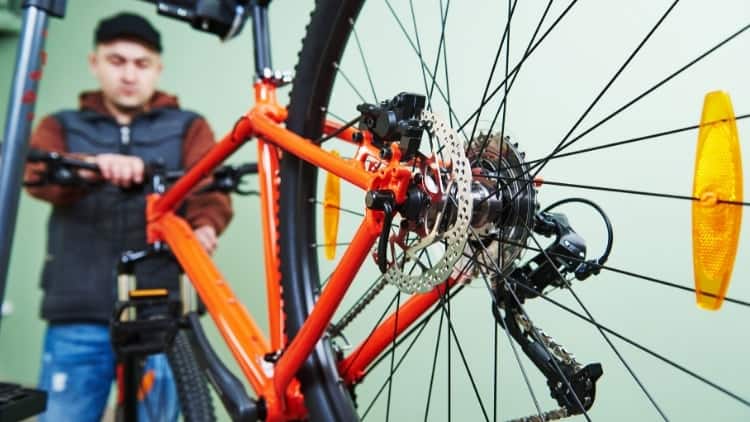
Inspect – Lift your front wheel off the ground and let your headset rotate a few times. Take care to listen for any noise and watch out for any “notching” in the rotation. Keep the bearings clean and lubricated as well.
Service – Take your bike to a Bike Shop if you have any concerns, as safety is a main priority
Frequency – As needed
Your headset plays a vital role in directing your input on the bike.
And believe it or not, your headset can really take a beating when you’re riding a lot of technical trails.
If you’re checking your bolts and keeping your bike clean, there’s not too much more you need to do.
But if you experience any twisting, grinding, or grooving, it’s time to take your bike in for a service.
Although the experienced bike mechanic can easily inspect this part, it’s best to have a professional take a look and advise on service.
If you notice any creaking or flex, schedule an appointment as soon as possible.
Inspect the Seat Post
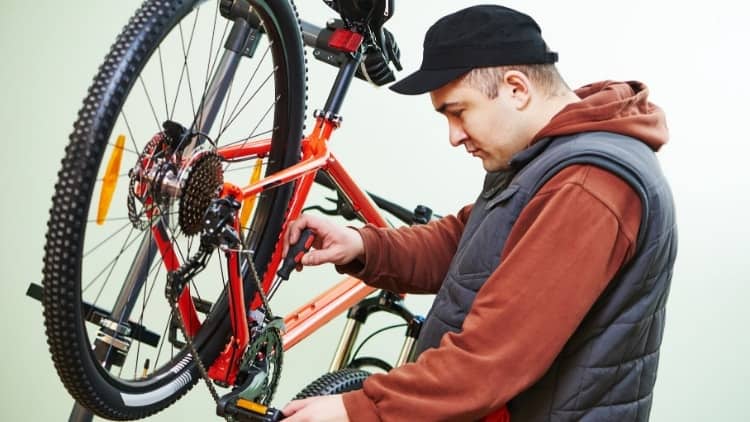
Inspect – Check for cracks or signs of stress, replace if damaged
Clean – Keep the seat clean so dirt stays out of the seat tube.
Frequency – Weekly
Your seat post takes quite a lot of force from riding, especially on a Hardtail.
Make sure you always check for integrity and cleaning to avoid damage.
This is more important for those who ride carbon.
Make sure you’re not over-tightening the bolts around your seat clamp, as this can really damage the bike and frame.
If you notice any creaking or noise, make sure you make an appointment at your LBS.
Check Axles
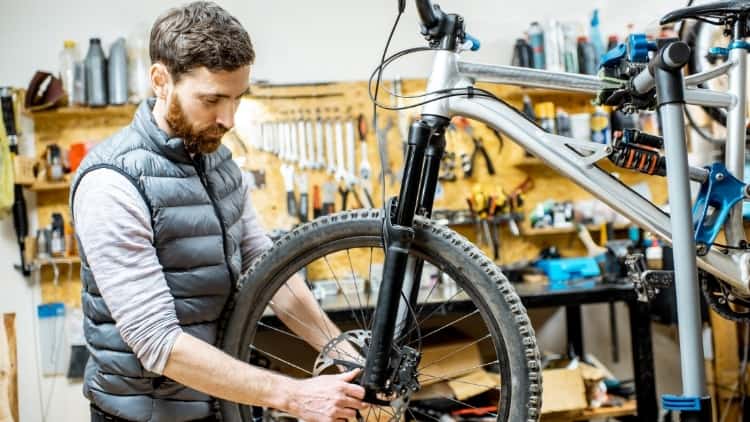
Inspect – Inspect for grooves or damage, which would prompt repair or replacement.
Clean – Clean dirt and grime from the axles and where they attach to the bike frame.
Lubricate – Apply a small amount of grease to each axle and wipe the excess with a clean cloth.
Frequency – Every other week
Your axles are mostly addressed with any issues with the wheels, but make sure you still give them attention.
Keeping your bike clean will help manage any issues in the area, however, you may need to service periodically through the year.
Keep them clean so you don’t cause wear to the rest of your bike and to make sure they’re running smoothly.
Any damage to the axles or frame is a clear sign to make a trip to your LBS.
Inspect the Pedals
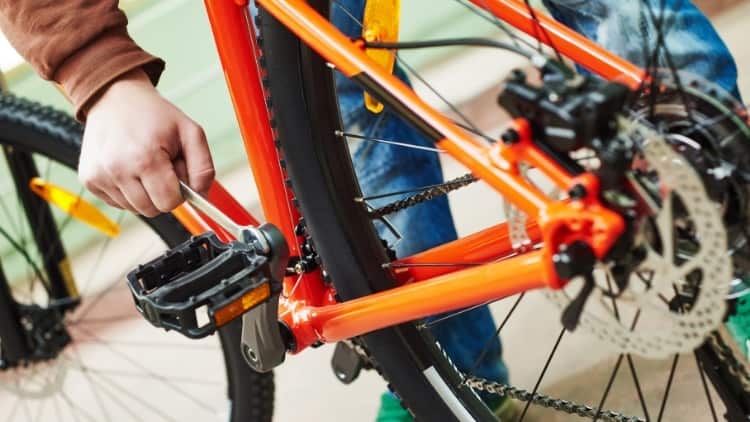
Inspect – Check for damage or missing components like pegs.
Clean – Use a degreaser and a scrub brush to get all the dirt from in between the pedal components.
Your pedals are your main connection to your bike, so make sure they’re cared for accordingly.
Damaged or failing MTB pedals can cause loss of grip and confidence, possibly even harm to the rider.
If you’re feeling any friction or rattling in your pedaling, make sure you give them an inspection.
Keeping them free of mud and grime can help prolong their life substantially.
Annual/Seasonal Tune-up

Regardless of how well you’re looking after your bike, I still recommend taking it in for a tune-up at least once a year.
Having the professionals take a look can help you catch things before they become a problem and can even introduce you to new information.
Most people get a tune-up just before or after the winter season but feel free to get one as you see fit.
Conclusion
In conclusion, staying on top of the maintenance of your Hardtail will significantly increase its life.
Make sure you use the appropriate lubrication and clean as often as possible.
Keep taking care of your Bike and it will keep taking care of you!

